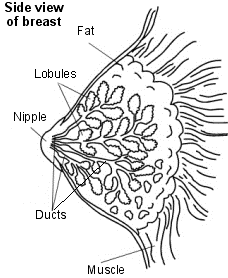Breast Cancer
Breast cancer is the most common cancer in women. Most cases occur in women over the age of 50 but breast cancer can occur in younger women. If you notice any lump or change to your normal breast then you should see a doctor promptly. If breast cancer is diagnosed at an early stage, there is a good chance of a cure. In general, the more advanced the cancer (the more it has grown and spread), the less chance that treatment will be curative. However, treatment can often slow the progress of the cancer.
The breasts
Breast tissue is attached to muscle on the chest wall. A tail of breast tissue extends up into the armpit. The breasts contain:
- Many lobules which are made up of glandular tissue. They make milk after pregnancy.
- Ducts. These are channels which take milk from the lobules to the nipple.
- Fatty tissue and supporting connective tissue.
- Blood vessels, lymph channels and nerves (like all other areas of the body).

What are the risk factors for breast cancer?
Although breast cancer can develop for no apparent reason, there are certain risk factors which increase the chance that breast cancer will develop. These include:
- Age. The risk of developing breast cancer roughly doubles for every 10 years of age. Most cases develop in women over the age of 50.
- Where you live. The rate of breast cancer varies between countries. This may reflect genetic or environmental factors.
- Family History. This means if you have close relatives who have or have had breast cancer. In particular, if they were aged under 50 when diagnosed.
- If you have had a previous breast cancer.
- Being childless, or if you had your first child after the age of 30.
- Not having breast-fed your children.
- Early age of starting periods.
- Chest being exposed to radiation.
- Having a menopause over the age of 55.
- Taking continuous combined hormone replacement therapy (HRT) for several years (in women over 50 years) leads to an increased risk.
- Excess alcohol.
Surgery
The types of operation which may be considered are:
- Breast-conserving surgery. This is often an option if the tumour is not too big. A lumpectomy (or wide local excision) is one type of operation where just the tumour and some surrounding breast tissue are removed. It is usual to have radiotherapy following this operation. This aims to kill any cancer cells which may have been left in the breast tissue.
- Removal of the affected breast (mastectomy). This may be necessary if there is a large tumour or a tumour in the middle of the breast. It is often possible to have breast reconstructive surgery to create a new breast following a mastectomy. This can often be done at the same time as the mastectomy, although it can also be done months or years later. There are now many different types of reconstruction operations available.
- A sentinel lymph node biopsy may be performed. This is a way of assessing if the main lymph nodes draining the breast contain cancer. If they are clear then the remaining lymph nodes in the armpit will not need to be removed. If it is not possible to do this, one or more of the lymph nodes in the armpit may be removed. This helps to stage the disease accurately and to guide the specialist as to what treatment to advise following surgery.
